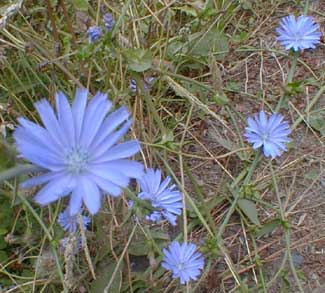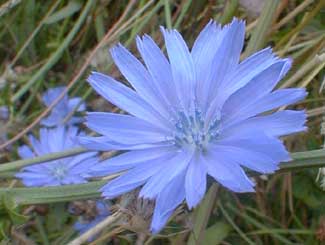
Chicory
"Say that it was a change,
but constant as a changing thing may be,
from chicory's moon-dark blue down the taut scale
to chicory's tenderest pink, in a pink field
such as imagination dreams of thought."
-Conrad Aiken
(1889-1973)
(1889-1973)
Driving about the main roads & the backroads & even up dirt roads everywhere on the Kitsap penninsula, summer's flowering chicory (Chichorium intybus) is seen together with the blooms of wild carrot (Daucus carota carota), tansy ragwort (Senecio jacobaea), daisies, & common tansy (Tanecetum vulgare) which all enjoy open sunny spots. The blue aster-like flowers of wild chicory are encountered in mixed meadow communities but also growing almost by themselves in the most inhospitable ground too dry & hard for most weeds.
 Originally native to Europe & western Asia, it has spread throughout the world, & is today common from one edge of North America to the other. Since it's now here to stay, it's a good thing that it is at least it's a pretty wildflower. Its blooms are most numerous in July & August. The flowers open every morning & remain open for as long as the sun is directly on them.
Originally native to Europe & western Asia, it has spread throughout the world, & is today common from one edge of North America to the other. Since it's now here to stay, it's a good thing that it is at least it's a pretty wildflower. Its blooms are most numerous in July & August. The flowers open every morning & remain open for as long as the sun is directly on them.A biennial or perennial, it can be anywhere from a foot or two tall, to six feet tall in flower. Nearly always of a pure light blue, occasionally races are seen that are pink or white, & occasionally pale blue flowers fade with a tinge of pink revealed. The familiar blue has lent it to be called Blue Daisy or Blue Sailors.
Its dandylion-like basal leaves are tender when very young & like dandylion leaves can be eaten raw in salads. Or the tender leaves & the second-year shoots of young flowerstems can be fried or used as a potherb. It is commonly grown as a garden vegetable which produces no flowers its first year, but provides leafy greens variously called witloof, succory, chicon, barbe-de-capuchi, or Belgian Endive (sometimes distinguished from Chichorum endiva as French Endive).
However, the leaves age with an unpleasant bitterness, so that older leaves are palatable only if boiled & the water discarded & boiled at least one more time & the water discarded. As this is a bother they are generally regarded as harvestable their first month for green salads, & for two or at most three months for potherbs. The name Chicory & the genus name Chichorium are derived from its Arabic name which was derived from the Egyptian for "January" because the leaves were eaten raw only in January. But there are cultivated varieties developed to have leaves that remain sweet for a longer season, the most popular being 'Witloof' & the red-leaf variety 'Radicchio'; these have broader untoothed leaves that more resemble lettuce.
It is famous as a coffee substitute. The deep taproot is dug up early autumn or late winter, dried, roasted, & ground up as an addition to regular coffee, or as no-caffeine alternative to coffee. For this popular use it has been called Coffeeweed.
Chicory is often recommended as a medicinal herb, either as a general tonic or as a diuretic or for topical treatment of gout or dermatitis. In the poorly or haphazardly regulated or entirely unregulated alternate medicine industry, chicory gets prescribed for all sorts of uses, the majority of which are unlikely, unproven, or definitely not possible, including in the latter category its alleged ability to treat diseases of the liver, kidney, or spleen.
Such use is not likely to be beneficial but it is at least not harmful as long as real problems are being assessed by real doctors. Reliance on folklore in lieu of seeking a physician's care is not alternative healing but ignorance apt to result in a slight improvement in the gene pool when some seriously ill herb-swilling moron drops dead from an untreated illness.
However, drinking chicory regularly in order to stop drinking coffee, or mixed with carob root for a mocha substitute, would be lots easier on one's health than drinking real coffee. Many individuals suffering from acid reflux & stomach acid could be well practically overnight if they could give up coffee. In that context chicory can be a secondary cause of improved health.